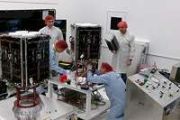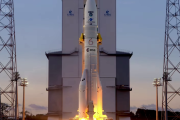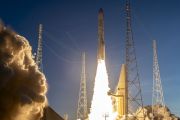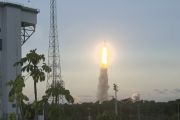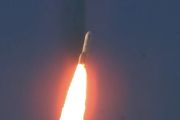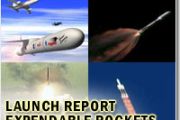
Copernical Team
Titan atmosphere wobbles like a gyroscope revealing seasonal shifts
 The unusual motion of Titan's atmosphere has been uncovered by scientists at the University of Bristol using data from NASA's Cassini-Huygens mission. Their research shows that Saturn's largest moon possesses an atmosphere that doesn't rotate in sync with its surface but instead exhibits a wobble resembling a gyroscope.
Through 13 years of thermal infrared measurements from the Cassini spa
The unusual motion of Titan's atmosphere has been uncovered by scientists at the University of Bristol using data from NASA's Cassini-Huygens mission. Their research shows that Saturn's largest moon possesses an atmosphere that doesn't rotate in sync with its surface but instead exhibits a wobble resembling a gyroscope.
Through 13 years of thermal infrared measurements from the Cassini spa Gold and precious metals traced to Earth's core in Hawaiian lava
 Researchers at the University of Gottingen have uncovered evidence that material from Earth's core, including gold and other precious metals, is leaking into the planet's upper layers. Their study, published in Nature, reports the detection of the rare isotope 100Ru (ruthenium) in volcanic rocks from Hawaii, indicating that the samples originated from deep within the core-mantle boundary, around
Researchers at the University of Gottingen have uncovered evidence that material from Earth's core, including gold and other precious metals, is leaking into the planet's upper layers. Their study, published in Nature, reports the detection of the rare isotope 100Ru (ruthenium) in volcanic rocks from Hawaii, indicating that the samples originated from deep within the core-mantle boundary, around Numerical models uncover how barred olivine crystals formed in ancient meteorites
 Researchers from Nagoya City University and Tohoku University have successfully simulated the formation of barred olivine, a rare mineral texture found in chondrules-small spherical particles within meteorites dating back to the early solar system. Unlike textures in Earth rocks, barred olivine is unique to these primordial materials.
Led by Associate Professor Hitoshi Miura, the team used
Researchers from Nagoya City University and Tohoku University have successfully simulated the formation of barred olivine, a rare mineral texture found in chondrules-small spherical particles within meteorites dating back to the early solar system. Unlike textures in Earth rocks, barred olivine is unique to these primordial materials.
Led by Associate Professor Hitoshi Miura, the team used Rocket Lab to deploy BlackSky Gen3 satellite on next Electron launch
 Rocket Lab USA has announced it will launch the next BlackSky Gen-3 satellite as part of its continued partnership with the real-time space-based intelligence company. The mission, named "Full Stream Ahead," is scheduled to lift off from Launch Complex 1 in New Zealand during a window opening May 28, 2025 (UTC).
This upcoming flight marks the second of four planned Electron missions this y
Rocket Lab USA has announced it will launch the next BlackSky Gen-3 satellite as part of its continued partnership with the real-time space-based intelligence company. The mission, named "Full Stream Ahead," is scheduled to lift off from Launch Complex 1 in New Zealand during a window opening May 28, 2025 (UTC).
This upcoming flight marks the second of four planned Electron missions this y SES selects Helios kick stage from Impulse for direct-to-orbit satellite missions
 Impulse Space and SES have entered a multi-launch agreement to utilize the Helios kick stage for direct satellite transfers from Low Earth Orbit (LEO) to Geostationary (GEO) and Medium Earth Orbits (MEO), significantly reducing orbital transit time to just hours.
The inaugural mission, slated for 2027, will see Helios transporting a 4-ton-class payload directly to GEO within eight hours af
Impulse Space and SES have entered a multi-launch agreement to utilize the Helios kick stage for direct satellite transfers from Low Earth Orbit (LEO) to Geostationary (GEO) and Medium Earth Orbits (MEO), significantly reducing orbital transit time to just hours.
The inaugural mission, slated for 2027, will see Helios transporting a 4-ton-class payload directly to GEO within eight hours af SpaceX sends up more Starlink satellites from California
 SpaceX launched another batch of 27 Starlink V2 Mini satellites into low-Earth orbit on Friday from California.
The Falcon 9 flight was delayed from Thursday night. No reason was given for the scrubbing.
The rocket lifted off 3:32 p.m. PDT from Vandenberg Space Force Base's Pad 4E.
A little more than eight minutes after liftoff, the first stage booster landed on the drones
SpaceX launched another batch of 27 Starlink V2 Mini satellites into low-Earth orbit on Friday from California.
The Falcon 9 flight was delayed from Thursday night. No reason was given for the scrubbing.
The rocket lifted off 3:32 p.m. PDT from Vandenberg Space Force Base's Pad 4E.
A little more than eight minutes after liftoff, the first stage booster landed on the drones S.Africa moves to ease black empowerment law under Starlink pressure
 South Africa's government is moving towards easing its black ownership laws in the telecoms sector - a policy change that would smooth the way for Elon Musk's Starlink to enter the local market.
The directive came days after South African President Cyril Ramaphosa met his US counterpart Donald Trump for tense talks on deteriorating ties between the two countries.
Telecoms companies oper
South Africa's government is moving towards easing its black ownership laws in the telecoms sector - a policy change that would smooth the way for Elon Musk's Starlink to enter the local market.
The directive came days after South African President Cyril Ramaphosa met his US counterpart Donald Trump for tense talks on deteriorating ties between the two countries.
Telecoms companies oper Doubt cast on claim of 'hints' of life on faraway planet
 When astronomers announced last month they might have discovered the most promising hints of alien life yet on a distant planet, the rare good news raised hopes humanity could soon learn we are not alone in the universe.
But several recent studies looking into the same data have found that there is not enough evidence to support such lofty claims, with one scientist accusing the astronomers
When astronomers announced last month they might have discovered the most promising hints of alien life yet on a distant planet, the rare good news raised hopes humanity could soon learn we are not alone in the universe.
But several recent studies looking into the same data have found that there is not enough evidence to support such lofty claims, with one scientist accusing the astronomers After two setbacks, SpaceX could try to launch massive Starship next week
This request seems a bit unusual, so we need to confirm that you're human. Please press and hold the button until it turns completely green. Thank you for your cooperation!
Press and hold the button
If you believe this is an error, please contact our support team.
185.132.36.159 : 761025ca-08f3-4d95-be77-6146a2ac
NASA-French Satellite Spots Large-Scale River Waves for First Time
 The SWOT mission captured the flood waves, which stretched from 47 to 166 miles long, as they traveled down rivers in Montana, Texas, and Georgia.
In a first, researchers from NASA and Virginia Tech used satellite data to measure the height and speed of potentially hazardous flood waves traveling down U.S. rivers. The three waves they tracked were likely caused by extreme rainfall and by a
The SWOT mission captured the flood waves, which stretched from 47 to 166 miles long, as they traveled down rivers in Montana, Texas, and Georgia.
In a first, researchers from NASA and Virginia Tech used satellite data to measure the height and speed of potentially hazardous flood waves traveling down U.S. rivers. The three waves they tracked were likely caused by extreme rainfall and by a 





